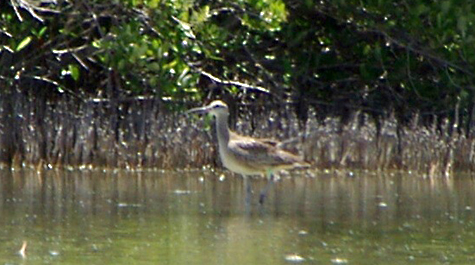Hope spotted in Virgin Islands
Bryan Watts, director of the center, said a birder named Lisa Yntema had been following Hope’s migration on the CCB’s web site. She found Hope foraging for crabs at Great Pond, a mangrove-fringed body of water that has been designated an Important Bird Area by Birdlife International, Watts said.
“It’s just amazing. This bird has been all over the place and then somebody sees it. Somehow Lisa got onto our web site and realized that one of our birds had stopped in St. Croix,” Watts said. “Then she went out to Great Pond and the bird was there. She identified the bird as Hope by its satellite transmitter and green leg flag.”
Yntema and researchers from the Center for Conservation Biology—along with thousands of interested birders—have been able to follow the often unpredictable migratory movements of Hope and several other whimbrels. These birds were trapped at staging grounds on the Eastern Shore and fitted with state-of-the-art 9.5-gram satellite transmitters in a collaborative effort by the CCB and the Virginia Chapter of the Nature Conservancy. The CCB is a joint program of the College of William & Mary and Virginia Commonwealth University. The updated tracking maps of Hope and other whimbrels are available online.
Hope made landfall on St. Croix on the evening of Aug. 14 after completing an extraordinary 100-hour, 3,500-mile flight out over the open ocean. She left South Hampton Island in upper Hudson Bay on Aug. 10, flying south over Hudson Bay, crossed the interior of Canada and New England to emerge from the coast of Maine and out over the open Atlantic. Once out over the ocean, Hope flew east beyond Bermuda before turning south and down to St. Croix.
“We expect hope to stage for a period of two to three weeks before making her way down to the coast of South America for the winter,” Watts said. He added that Great Pond, although known for holding important species such as white-crowned pigeons, green-throated caribs and Antillean crested hummingbirds, does not attract large numbers of migrating whimbrels.
“Lisa sent me a log of whimbrel sightings over the past three or four years,” Watts said. “They don’t get a whole lot; her peak count there since 2003 has been 20 in August of 2008. That high count have been caused by a series of storms. When Hope was out over the water, we were wondering if she were going to stop somewhere in the Caribbean, or just keep going.”
Satellite tracking of whimbrel migrations are giving scientists at the CCB insight into the population dynamics and re-writing the natural history of the species. Last year, Winnie, a whimbrel tagged on the Eastern Shore, stunned scientists by flying to the Mackenzie River near the Canada-Alaska border. Watts and other researchers expected Winnie to make a much shorter flight to the Hudson Bay area.
Willie a 2008 “classmate” of Winnie, dropped out of satellite contact last year near Guyana, but was spotted by researchers this year working on the Eastern Shore. Boxer, a whimbrel tagged this spring, is also back on the Eastern Shore after a trip to Hudson Bay.
Watts explained that whimbrels breed in the north—sometimes well above the arctic circle—then winter in South America. Marshy, crab-rich areas such as the Eastern Shore are important staging areas for the birds, which stop to rest and feed on their long migratory flights.
 Skip to main content
Skip to main content

